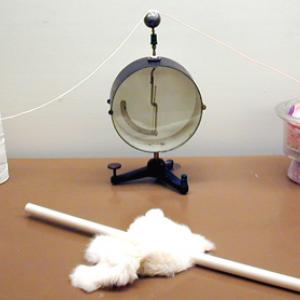College of Liberal Arts & Sciences
5A30.10 - Electroscope - Wire vs. String
Set the electroscope so that it has a string and copper wire connected to it. Connect the other end of the string to one of the plastic supports and set to one side of the electroscope. The copper wire can be connected to the plastic support on the other side of the electroscope. When the charged PVC rod is brought near the string there is no change observed on the electroscope. Bringing the charged rod to the copper wire will show a instantaneous response on the electroscope.
- Xueli Zou, "Conductors and Insulators: A QuickTime Movie", TPT, Vol. 43, # 7, p. 460.
Disclaimer: These demonstrations are provided only for illustrative use by persons affiliated with The University of Iowa and only under the direction of a trained instructor or physicist. The University of Iowa is not responsible for demonstrations performed by those using their own equipment or who choose to use this reference material for their own purpose. The demonstrations included here are within the public domain and can be found in materials contained in libraries, bookstores, and through electronic sources. Performing all or any portion of any of these demonstrations, with or without revisions not depicted here entails inherent risks. These risks include, without limitation, bodily injury (and possibly death), including risks to health that may be temporary or permanent and that may exacerbate a pre-existing medical condition; and property loss or damage. Anyone performing any part of these demonstrations, even with revisions, knowingly and voluntarily assumes all risks associated with them.
